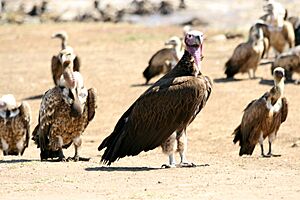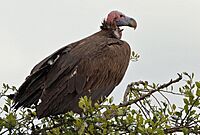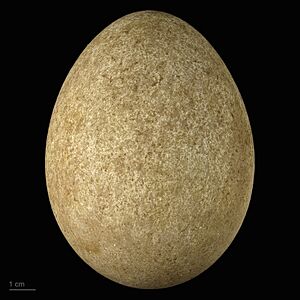Lappet-faced vulture facts for kids
Quick facts for kids Lappet-faced vulture |
|
|---|---|
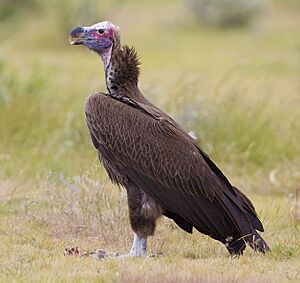 |
|
| At Etosha National Park, Namibia | |
| Conservation status | |
| Scientific classification | |
| Genus: |
Torgos
|
| Species: |
tracheliotos
|
| Subspecies | |
|
|
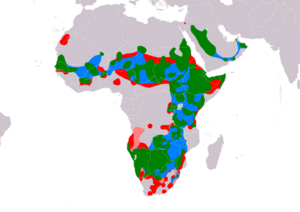 |
|
| Range of T. tracheliotos Resident Possibly Extant (resident) Non-breeding Extinct Probably extinct | |
| Synonyms | |
|
Torgos tracheliotus (lapsus) Vultur tracheliotos J. R. Forster, 1796 Vultur auricularis Daudin, 1800 Vultur aegypius Temminck, 1826 Vultur imperialis Temminck, 1827 Vultur nubicus H. Smith, 1829 |
|
The lappet-faced vulture (also known as the Nubian vulture) is a very large Old World vulture. Its scientific name is Torgos tracheliotos. This amazing bird belongs to the group of birds called Accipitriformes. This group also includes other powerful birds like eagles, kites, buzzards, and hawks. The lappet-faced vulture is the only species in its genus, Torgos.
Even though it looks a bit like New World vultures, it's not closely related to them. Unlike some New World vultures, the lappet-faced vulture doesn't have a very good sense of smell. It mostly relies on its excellent eyesight to find food.
There are two main types, or subspecies, of lappet-faced vultures. One type lives all over Africa. The other type, called T. t. negevensis, looks a bit different and lives only in the Arabian peninsula.
Contents
What's in a Name?
The scientific name for this vulture, Torgos tracheliotos, comes from Greek words. It means "Cartilage-eared Vulture." This name describes the special fleshy folds, or "lappets," on the sides of its head.
Where Do Lappet-faced Vultures Live?
Lappet-faced vultures are found in many parts of Africa and the Arabian Peninsula. However, they are not found everywhere in these regions. Their numbers are decreasing in some areas.
These vultures breed in many African countries. These include Senegal, Mali, Ethiopia, Kenya, Tanzania, South Africa, and Namibia. In the Arabian Peninsula, they breed in Yemen, Oman, and Saudi Arabia. They have also been seen in other countries like Gambia and Angola.
What Kind of Places Do They Like?
These vultures prefer to live in dry, open areas. They like places such as savannahs with scattered thorn bushes. They also live in deserts with a few trees, or on open mountain slopes. They usually choose quiet, open areas with not too much grass.
Sometimes, they might fly into areas with more trees or even near human towns. This often happens when they are looking for food, especially if there are dead animals on roads. They can live at many different heights, from sea-level up to about 4,500 m (14,800 ft) high.
How to Spot a Lappet-faced Vulture
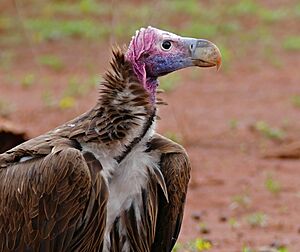
The lappet-faced vulture is a very large bird. It has the longest body and largest wingspan among vultures in its home range. It can be up to 115 cm (45 in) long. Its wings can spread out to almost 2.9 m (9.5 ft) wide! While some other vultures might be heavier, the lappet-faced vulture is truly massive. Its beak is also huge, measuring up to 10 cm (3.9 in) long.
African lappet-faced vultures usually weigh between 4.4 to 9.4 kg (9.7 to 20.7 lb). The Arabian subspecies can be even heavier. Males weigh 6.5–9.2 kg (14–20 lb), and females can weigh up to 13.6 kg (30 lb).
Most lappet-faced vultures are blackish on top. Their thigh feathers are a bright white, which stands out. African birds have brown lines on their black back feathers. Arabian birds are dark brown on top instead of black. Their underside can be white or light brown.
Like many vultures, they have a bald head. This is helpful because a feathered head would get messy when they eat. The color of their head can be reddish, pink, or gray depending on where they live. The fleshy folds, or lappets, on the sides of their head are very unique.
When flying, these vultures hold their large, wide wings straight out. Their wingtips look a bit jagged. It's hard to confuse them with other vultures. They are much bigger than the hooded vulture and have a much larger beak. Other vultures like the Gyps species are usually paler. The cinereous vulture looks similar in shape but is completely dark.
Lappet-faced Vulture Behavior
What Do Lappet-faced Vultures Eat?
Lappet-faced vultures are scavengers. This means they mostly eat dead animals, called carrion. They find these carcasses by using their amazing eyesight. They also watch other vultures to see where they are gathering.
These vultures are very strong and can tear through tough animal hides. They are often the first to open up a large carcass. Other vultures usually let the lappet-faced vulture eat first. This helps the smaller vultures. Once the lappet-faced vulture tears open the skin, the others can then get to the meat.
Sometimes, lappet-faced vultures wait until other vultures are done eating. Then they feed on the leftover skin, tendons, and other tough parts. They prefer large animals like elephants because these provide a lot of food. A vulture can eat up to 1.5 kg (3.3 lb) of meat in one meal!
Unlike most vultures, lappet-faced vultures sometimes hunt smaller animals. They have been seen eating small mammals, birds, and reptiles. They might steal food from eagles. They are also believed to sometimes attack young or weak animals. They have been known to eat flamingo eggs, young, and even adult flamingos. They might also hunt young impalas or guineafowl. They are thought to hunt by dropping onto their prey from above. This stuns the prey, and then they use their strong beaks to tear it apart.
Lappet-faced Vulture Life Cycle and Reproduction
Lappet-faced vultures usually live alone. They don't nest in large groups like some smaller vultures. You'll typically find only one or two nests in an area. Sometimes, up to 10 nests might be found close together. Each pair of vultures needs a large area to live in, usually at least 8 to 15 km (5.0 to 9.3 mi) wide. While they are often alone, groups of up to 50 can gather at very large carcasses or watering holes.
These vultures build huge nests made of sticks. A nest can be 120–220 cm (47–87 in) wide and 30–70 cm (12–28 in) deep. They often line their nests with green leaves, animal hair, and skins. Nests are usually built in the main fork or top of an Acacia tree. They are placed high up, about 5 to 15 m (16 to 49 ft) off the ground.
The female lays one or two eggs. Both parents take turns sitting on the eggs for about 54 to 56 days. The young birds leave the nest when they are 124 to 135 days old. However, they might stay with their parents for a year or more. This sometimes means the parents only nest every other year. Lappet-faced vultures usually don't start breeding until they are about six years old.
Lappet-faced Vulture Conservation Status
The number of lappet-faced vultures in the world has been decreasing. Because of this, their conservation status was changed to "Endangered" in 2015. They are declining in many parts of Africa. Their population in Arabia is stable, but it's a small group. They are no longer found breeding in Israel.
Most of these declines are due to human activities. This includes losing their habitat because of farming and development. Disturbances at their nesting sites also affect them, as they are quite sensitive. A big problem is also poisons. These poisons are often put out to control animals like jackals. Vultures then eat the poisoned animals and die.
Sometimes, farmers mistakenly believe vultures are killing their livestock. This has led to vultures being shot or poisoned. For example, in Namibia, 86 vultures died after eating poisoned cattle. Poachers also sometimes poison carcasses. They do this to prevent vultures from circling above, which could alert park rangers to their illegal activities.
In 2019, over 500 vultures of different species, including 14 lappet-faced vultures, died in northern Botswana. It is thought they ate elephants that were poisoned by poachers. This shows how important vultures are to the ecosystem and how much they are at risk.
There is some good news. On April 3, 2022, the Israel Nature and Parks Authority announced the first lappet-faced vulture chick to hatch in Israel since 1994. This shows that conservation efforts can help. The estimated world population of lappet-faced vultures is currently less than 9,000 individuals.



